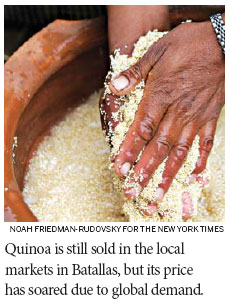Health
Food's success creates a quandary
Updated: 2011-03-27 07:28
By Simon Romero and Sara Shahriari (New York Times)

LA PAZ, Bolivia - When NASA scientists were searching decades ago for an ideal food for long-term human space missions, they came across an Andean plant called quinoa. With an exceptional balance of protein and amino acids, quinoa, they declared, is virtually unrivaled in the plant or animal kingdom for its life-sustaining nutrients.
Now demand for quinoa is soaring as American and European consumers discover the "lost crop" of the Incas. The surge has helped raise farmers' incomes in Bolivia, where it has been a staple for centuries. But there has been a notable trade-off: Fewer Bolivians can now afford it.
While quinoa prices have almost tripled over the past five years, Bolivia's consumption of the staple fell 34 percent over the same period, according to the country's agricultural ministry. This has raised fear of malnutrition in one of the hemisphere's poorest countries.
The shift offers a glimpse into the consequences of rising global food prices and changing eating habits in both prosperous and developing nations.
Quinoa is a chenopod, related to species like beets and spinach. Its seeds have a light, nutty taste, and when cooked become almost translucent.
The recent focus on foreign markets has altered life in isolated places like Salinas de Garci Mendoza in southern Bolivia, where much of the country's quinoa is produced. Agricultural leaders claim that rising exports of the plant have lifted living standards there and in other quinoa-growing areas.
"Before quinoa was at the price it is now, people went to Argentina and Chile to work," said Miguel Choque Llanos, commercial director of the National Association of Quinoa Producers. Now, he said, rising quinoa prices have also encouraged city dwellers to return to their plots in the countryside during planting and harvest seasons.
Yet there are causes for concern. Maria Julia Cabrerizo, a nutritionist, said studies showed that chronic malnutrition in children had climbed in quinoa-growing areas, including Salinas de Garci Mendoza, in recent years.
"I adore quinoa, but I can't afford it anymore," said Micaela Huanca, 50, a street vendor in the slums above La Paz. "I look at it in the markets and walk away."
But officials in President Evo Morales's government say that changing food preferences and increased ability to buy processed foods play a role in the decreasing domestic consumption of quinoa.
"It has to do with food culture, because if you give the kids toasted quinoa flour, they don't want it; they want white bread," said Victor Hugo Vasquez, vice minister of rural development and agriculture.
David Schnorr, the president of the Quinoa Corporation of Los Angeles, an importer, is also concerned. "At $5 a box, only so many people can afford that," he said. He would prefer a price about half that amount. In Bolivia, a 1,000-gram bag of quinoa costs $4.85, compared with $1 for a bag of white rice.
President Morales said this month that he planned to make more than $10 million in loans available to organic quinoa producers, and health officials are incorporating the plant into a packet of foods supplied to thousands of pregnant and nursing women each month.
Some here cling to eating quinoa despite its rising price. Paulina Vasquez, 52, sows the crop each year on her family's land outside La Paz. She then prepares it by hand, a painstaking process that includes washing away the resinlike saponin coating that protects the seeds.
But she says her children have turned away from quinoa. "People my age and older are eating quinoa," Ms. Vasquez said. "The young people don't want it. If there is a pot of noodles everyone is there, as if noodles were nutritious. Even my children are that way."
The New York Times
(China Daily 03/27/2011 page9)
Specials

Tea-ing up
More turning to Chinese tea for investment opportunities like vintage wine

A cut above
The ancient city of Luoyang is home to a treasure trove of cultural wonders.

Rise and shine
The Chinese solar energy industry is heating up following recent setbacks in the nuclear sector